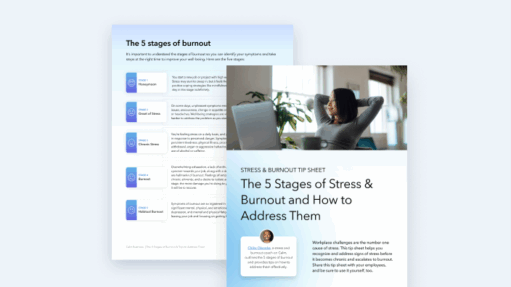The risk of widespread employee burnout should concern leaders in all industries. Employee stress is prevalent, particularly among millennials, and engagement is on the decline. Left unchecked, employee stress can escalate to burnout, mental and physical health challenges, high rates of turnover, and even more employee stress and disengagement.
It’s a vicious cycle with serious negative consequences to workforce and organizational health and well-being. In the short term, disrupting the cycle depends on identifying the early warning signs of burnout and taking steps to support affected employees.
Employee stress and burnout are on the rise while engagement falls
Recent large-scale employee surveys point to rising employee stress and declining employee engagement. For example:
- In 2024, nearly three-quarters (74%) of employees reported feeling moderate work-related stress. Almost 4 in 10 employees (38%) reported experiencing high levels of stress, up from 33% in 2023.
- Nearly 6 in 10 (59%) of employees are experiencing at least a moderate level of burnout, and almost 1 in 4 (23%) are experiencing high burnout. Two-thirds of millennials (66%) say they’re facing moderate or high burnout, compared to 39% of boomers.
- Employee engagement fell globally to 21% in 2024 from 23% in 2023, according to the Gallup State of the Workplace survey. Manager engagement fell from 30% to 27%, with the largest declines seen among female managers (7%) and managers under 35 (5%). Individual contributor engagement remained flat at 18%.
According to these surveys, heavy workloads are the primary source of stress for employees, and unprecedented disruption over the past five years (e.g., supply chain disruption, organizational restructuring, shrinking budgets) is the primary reason for manager stress and disengagement.
Organizations aiming to halt the vicious cycle of stress and burnout will need to implement long-term strategies that target these root causes and mitigate their impact. In the short-term, however, curbing burnout among employees depends on identifying warning signs and intervening. By becoming aware of signs of chronic stress and burnout, you can take steps to help yourself and your employees before burnout takes root and becomes habitual.
Identifying signs of burnout
Although we manifest stress in our own ways, the path to burnout is littered with signs, some more obvious than others. In general, you’re looking for changes in a person’s normal work behavior.
Here are some of the more subtle signs of burnout that you may be overlooking. Alone, none of these definitively point to burnout, but taken together, they may signal that someone is in need of support.
Employee burnout can look like:
1. Loss of confidence
If an employee suddenly seems to lose confidence in their abilities, it could be a sign they’re experiencing burnout. A loss of confidence may manifest as an employee who’s convinced their work will always be rejected or who becomes more tentative than usual. They may turn down opportunities to take on a new project or showcase their work in front of others. They may even begin to believe and express that they’re incompetent, disliked, or unwanted.
2, A change in socializing at work
Burnout can sometimes mimic symptoms of depression, leading people to feel lethargic and disconnected. If an employee seems exhausted all the time and is skipping plans or turning down favorite activities, they could be experiencing chronic stress or burnout. Burnout could also be the reason an employee suddenly becomes cynical about their work relationships or their perceived place in the company.
3. A change in general behavior
If an employee suddenly shows a drastic dip in energy—for example, they seem disinterested and unspirited compared to how they usually behave—it could be a sign they’re becoming disengaged, which is a marker of burnout. Or perhaps they’re showing a lot less patience than usual when interacting with colleagues or customers. This change in behavior could be a result of chronic stress or burnout.
Likewise, a sudden change in eating habits—eating either more or less—may also signal impending burnout. That’s because people suffering from burnout may overeat in an attempt to improve their short-term happiness. Or they may feel so stressed or down that they don’t even feel like eating.
4. Lack of care at work
Another common sign of burnout is suddenly becoming apathetic or a lot less careful at work—whether in regard to their attention to detail or their attitude.
For example, there may be more absenteeism or a reckless, devil-may-care attitude. Either could signal that the person no longer cares about their job, which could be a result of an underlying issue like burnout.
5. Physical illness and/or absenteeism
Finally, if you notice someone is absent more often or complaining about ailments, you should pay attention. Burnout can cause physical symptoms, such as headaches, stomach trouble, body aches, and increased susceptibility to flu and colds. A sudden uptick in days off could be symptomatic of someone who is burned out and unable to face work.
If you see signs of burnout, start the conversation…
Above all, when you see signs of burnout in a team member, don’t stay silent. Make sure you know they care about their well-being and start the conversation. You could note the changes in behavior you’re seeing and ask them if they want to talk.
Or, if you’re concerned they may feel unappreciated, try offering some positive reinforcement as you inquire about their well-being. For instance, you might say, “I learned a lot from your presentation last week, and I’d love to hear more. But I also want to check in to see how you’re feeling.”
Ultimately, if you or someone you know is struggling with chronic stress or burnout, the best way to turn it around is by reducing workplace stress. This could mean asking for more help, setting boundaries, or even switching to a new job. Just as burnout doesn’t happen overnight, neither do these solutions. In the meantime, try to find ways to support yourself and others. For example, celebrating small accomplishments or finding things to be grateful for can help boost well-being.
Learn about the 5 stages of burnout and how to address them
Get the tip sheet
Calm resources to explore for chronic stress and burnout
For more tips on how to help employees struggling with burnout, explore these resources:
Calm Health evidence-based programs developed by clinical psychologists:
- Workplace Well-being video series
- Build Stress Resilience
- Stress Management for Busy Nurses
- Physician Burnout: Protecting Your Well-being
- Veterinarian Burnout: Protecting Your Well-being
Wisdom series available on Calm Health and Calm:
- Stress and Burnout Support, Dr. Aditi Nerurkar
- Burnout (Daily Jay with Jay Shetty)
Webinars:
Guides and Blog Posts:
- Stress & Burnout Tip Sheet: The 5 Stages of Burnout & Tips to Address Them
- Everything You Need to Know About Burnout at Work with tips on how to help
- How to Deal with Burnout at Work: 6 Tips to Help You Cope
- Self-care Tools for HR Professionals to Reduce Stress and Prevent Burnout


